Southern California's best dive encounters
California is home to a highly diverse scenery above and below the waves. Northern California is covered in Giant Redwood forests and sweeping views of rugged terrain. Areas like Monterrey, Big Sur and Point Lobos State Natural Reserve provide divers an amazing view of a protected underwater realm. Meanwhile, the Central Coast of California is a gateway to the Channel Islands, where one of the largest Marine preserves in the country reside. Large animals like Orcas and the Grey Whale travel through the Channel Islands and grace bubble-makers with an unparalleled diving experience! As a traveler moves further south along the longest continuous state coastline in America, they'll find more beautiful water and enjoy many amazing areas that span from San Diego to Los Angeles. There is no doubt in any diver's mind that Southern California is a unique diving experience that must be jotted down on a bucket list and achieved! Whether you are looking for deep wrecks, kelp forests or swimming with some very large animals; you'll find it in SoCal.
Millions of underwater inhabitants allow a diver to enjoy substantial viewings in a short amount of time and give divers plenty to talk about when they surface on the world-class beachheads to spend the rest of their day!
Here's a few of Southern California diver's favorite encounters!
The "big'uns":
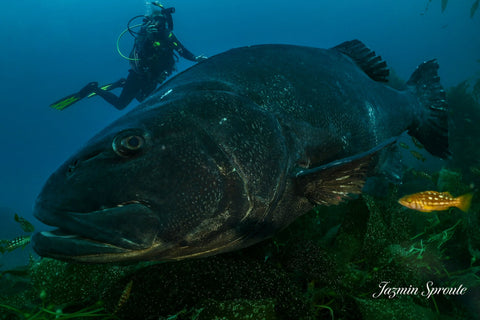
Giant Black Sea Bass - Photo Courtesy of Jazmin Sproule
Giant Black Sea Bass
Meet Stereolepis gigas. Commonly known as the Giant Black Sea Bass (GSB), this behemoth can reach lengths of 7ft and weigh as much as 700lbs. This fish was sought after by fishermen and eventually found itself on an endangered species list; this prompted the California Department of Fish and Game to ban the fishing of the GSB in 1982. Slowly, but surely, the population is finding itself back in a common sighting for SoCal divers. The GSB find hunting grounds amongst shallow rocky reefs in California and tend to stay in their areas for some time. They utilize their giant maw to rapidly suck a prey into their mouths for feeding and they love to eat just about anything on the reef. At the time of this writing, GSB's are currently hanging out at the Casino Point in Catalina and along the California coast at Heisler Park. They are a curious fish that will circle a diver and inspect them with their large eyes before moving along elsewhere along the reef. They are quite a treat to see on a dive!
_________________________________________________________________
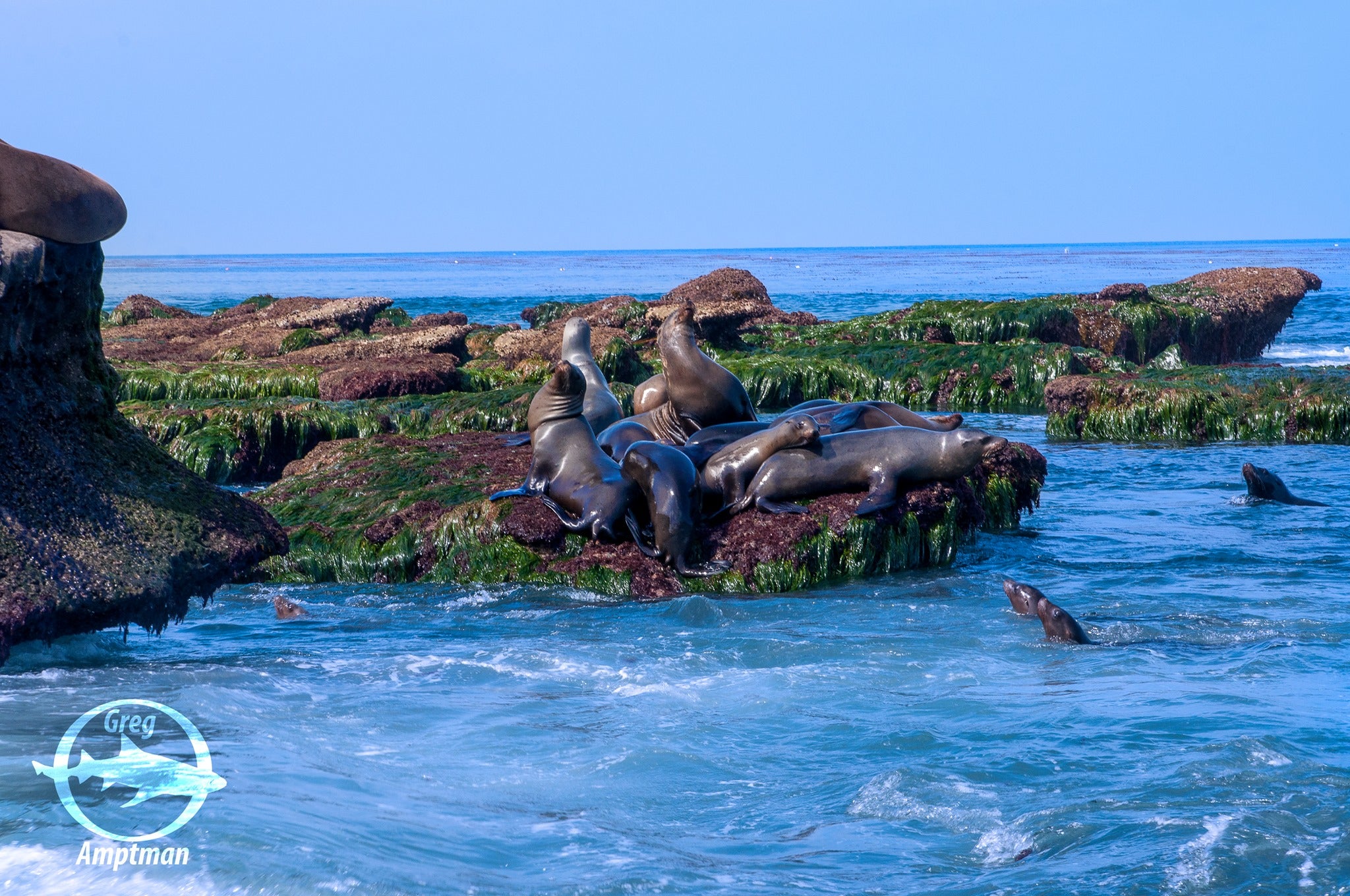
California Sea Lions lounging about - Photo by Greg Amptman
California Sea Lions
Zalophus californianus is a carnivore that is very common along Southern California shorelines. They can live up to 30 years of age and weigh in at a whopping 800+ lbs upon full maturity. The California Sea Lion is the fastest of its family where it can reach speeds of 25 miles an hour. They are a social animal that many top-siders can enjoy as they lay about on docks, moorings, rocks and more. They are extremely smart hunters and can remain below the surface for 10 minutes. They are the ire of fishing boats, as sea lions will comfortably chill below a boat and snag fighting fish directly off reels for some lazy meals. The California Sea Lions are always fun to interact with but do require caution as they are a territorial wild animal. Divers in Southern California will travel to the Los Coronados Islands, La Jolla Cove, San Clemente's Seal Rock and Crescent Bay North's Seal Rock for a chance to encounter these animals. At Shaw's Cove, it is not uncommon to have a Sea Lion join a diver on a night dive. The resident there enjoys using a diver's lights to help hunt!
_________________________________________________________________
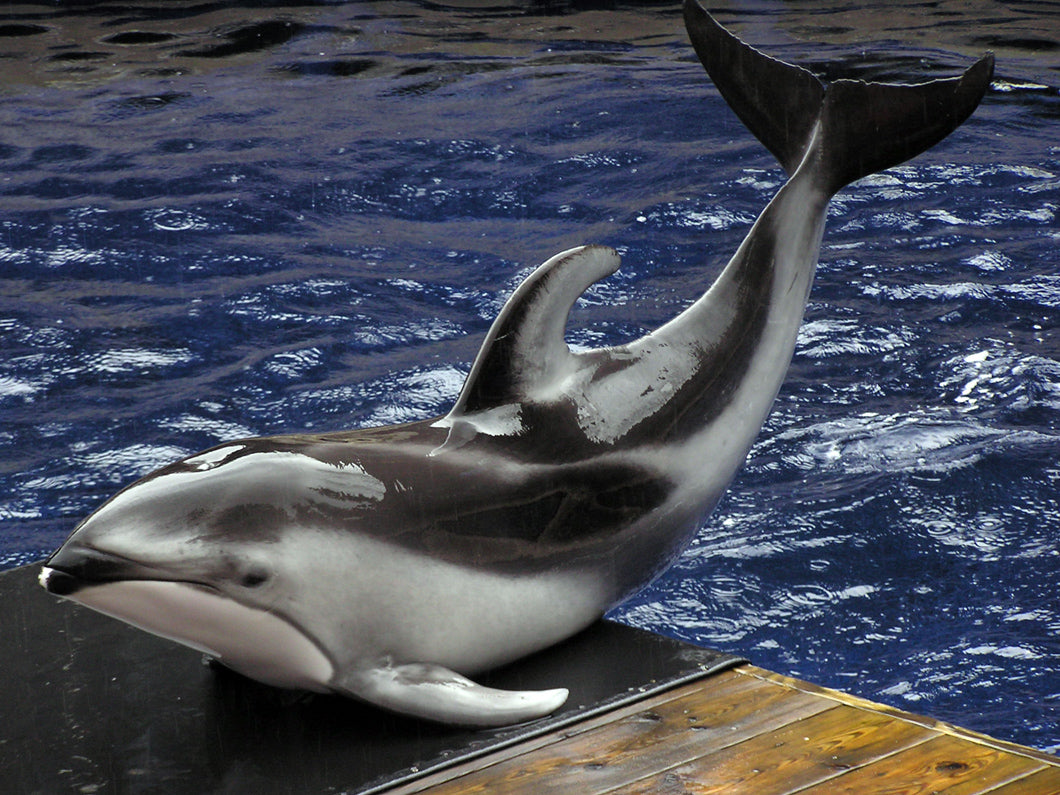
A Pacific White-Sided Dolphin at the Vancouver Aquarium - Photo by Yummifruitbat
Pacific White-Sided Dolphin
Lagenorhynchus obliquidens is known as the Pacific White-Sided Dolphin and are protected by the Marine Mammal Protection Act. They are most noticeable in California waters because of their white stripes when they are cresting the surface of the water or viewed underneath the waves. They have a short beak and look very similar to a porpoise. The Pacific White-Sided Dolphin is highly sociable and is often viewed by boaters when the dolphins decide to surf the wakes of their boats. They are not shy when it comes to acrobatic maneuvers and often hunt in groups, which provide amazing views for observers. Surfers and divers alike will experience close encounters with a dolphin and there are many tales of watching dolphins surf the waves along the SoCal coastline. They are always fun to see under the water!
_________________________________________________________________
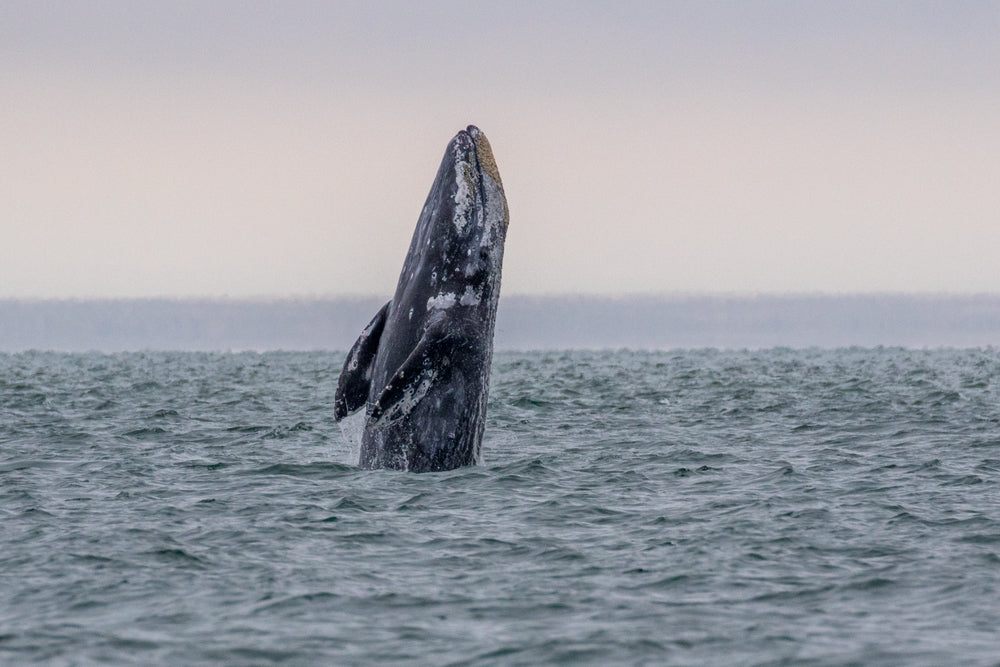
Gray Whale - Photo taken by SpringTide Crew
Gray Whale
Eschrichtius robustus is an amazing thing to see in Southern California waters. This animal travels between Mexico and Alaska and provide whale watching tours a view unlike any other. Reaching 30-40 tons and 40-50 feet, a Gray Whale is a very noticeable passerby in Southern California. They are often covered in organisms and will provide onlookers with views of their tails (also known as flukes) and gigantic blowholes when they surface for air. Their two blowholes are positioned in such a way that when they exhale, their spout appears to be heart shaped. For Southern California divers, a gray whale is so large that it often creates a visual disturbance in the water when it passes. An animal that exceeds the length of full size school busses are wary of boats and will often travel or dive well away from them. On occasion, divers and sight-seers will get to enjoy a breaching whale or catch a glimpse of their beautiful flukes.
_________________________________________________________________
The common ones:

Pacific Barracuda - Photo by Mark H.
Pacific Barracuda
Sphyraena Argentea is a schooling fish that is often found in large packs throughout Southern California. It is a predatory fish that spans from the southern tip of Baja Mexico all the way up to coastal Washington state. They can grow to over 3ft long and weigh in at 15lbs. During winter, the Pacific Barracuda will move south to warmer hunting grounds before moving back into our favorite Southern California dives sites and becoming a treat to see while out in the water. These fish are aggressive hunters of smaller fish and are inquisitive by nature. They are attracted to shiny objects and will come close to a diver to take a look. Considering their sharp teeth, it is safer to maintain a distance and enjoy their beautiful views from afar!
_________________________________________________________________

Garibaldi - Photo courtesy of Istockphoto
The Elusive Garibaldi
Hypsypops rubicundus can be easily identified by its bright orange coloration and inquisitive personality. Unlike other damselfish, who reside in warm tropical waters, Garibaldi can be found in temperate waters off the California coast from Monterey Bay down to the northern Baja coastline waters of Mexico. After over two decades of the Aquarium industry aggressively targeting the Garibaldi, California passed legislation in 1993 to protect these fabulous fish. In 1995, the Garibaldi was officially named the California State Marine Fish and are completely protected under state law from being removed from their habitats. The male Garibaldi is the housemaker of a mating pair. Not only does he select the nesting area, but he thoroughly prepares and maintains the area for the female to lay her eggs. Garibaldi are also very territorial and have meticulous boundaries of where one nest ends and the other begins. Be careful not to get too close! They have been known to chase divers away from their nesting areas. One of the authors may have been bitten by a combative garibaldi while photographing its nest. If you are diving in California, you can bet you will be able to see some of these vibrant fish!
_________________________________________________________________
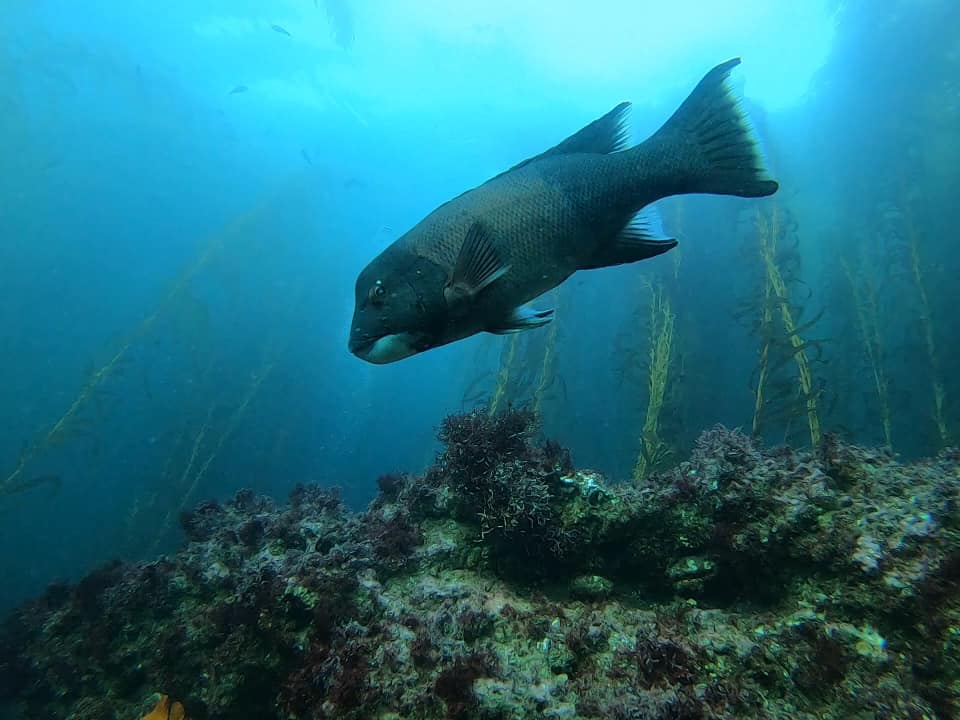
Sheephead - Photo courtesy of djmansfield.com
California Sheephead
Semicossyphus pulcher are an incredibly long-lived fish species that inhabits the rocky reef and kelp beds of California. Its maximum known lifespan in the wild is 53 years! However, most Sheephead do not reach this age due to fishing demands. Males can be distinguished by their black and orange midsection, white chin, red eyes and prominent bulbous foreheads. Females are typically smaller than the males and are more of a dull pink in color with white undersides. These fish are sequentially hermaphroditic as adults. Which means they are all born female and can develop into a fully functioning male after reaching a certain maturity level and size. Environmental conditions and the ratio of males to females in their local populations spark this unidirectional sex change. As a male, this fish establishes a spawning territory during mating season and protects a group of females with which he breeds. If you’re diving in California, you’re likely to see at least one of these canine-toothed fish!
_________________________________________________________________

Moray Eel - Photo Courtesy of Charles H.
The California Moray Eel
Gymnothorax mordax is a long, slim snakelike fish that is light to dark brown or green in color. Divers will typically find them tucked away in crevices during the day and prowling the reef for prey at night. The moray eel lacks pelvic fins, pectoral fins and gill covers. Most fish breathe by opening and closing their gill covers to force water over their gills. Since moray eels lack gill covers, they constantly open and close their mouths to push water over their gills, so it appears to be regularly gasping for breath (or waiting for the end of a bad joke). Scientists hypothesize that the California Moray’s off the Southern California Coast do not reproduce – possibly due to the cold-water temperatures. Moray’s living here are thought to hatch off the coast of Baja California and drift north as larvae. A distinguishable feature of the moray eel is the “second set” of jaws located in the back of their throat, also known as pharyngeal jaws. When the eel’s front jaws bite into its prey, the pharyngeal jaws spring forward and latch onto the prey while dragging them deeper into the moray’s throat. Along with their two sets of jaws, moray’s also have dagger-like teeth that are full of bacteria. Even though a moray will not bite unless provoked, be sure to keep your hands to yourself and do not reach into moray territory crevices.
_________________________________________________________________

Octopus - Photo Courtesy of Greg A.
Pacific Red Octopus
Octopus rubescens is known as the Pacific Red Octopus and can be found from Alaska to Baja California on the sandy or rocky bottoms of kelp forests to depths of 200m. This octopus is best identified by having three "eyelashes," or papillae, underneath its eyes and is typically red or brown in color. With arms around four times the length of its body, they typically hunt for marine invertebrates (crabs being a particular favorite) and fishes late into the night. Not only do octopuses have excellent sight, but they use each suction cup to taste, smell, and sense their surroundings. Be careful not to touch these guys! They have a powerful venom filled beak that they use to penetrate and poison their prey. Octopuses are gonochoric, where both male and female adults usually die shortly after spawning and brooding. They are considered to be the smartest invertebrate species, and potentially as intelligent as a house cat. However, not nearly as fluffy.
_________________________________________________________________
The "itty-bitty'uns":
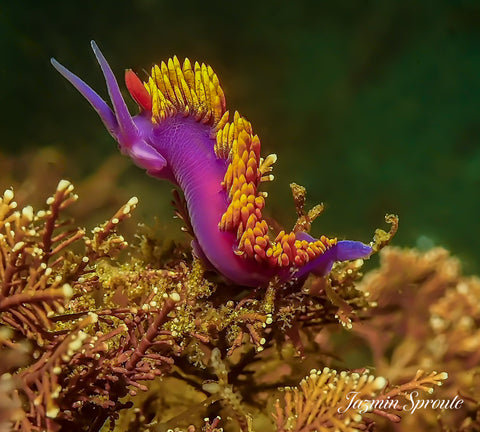
Spanish Shawl - Photo Courtesy of Jazmin Sproule
The Spanish Shawl
Flabellinopsis iodinea is a species of aeolid nudibranch that is so vibrant it will stop divers in their tracks! The body of the Spanish Shawl Nudibranch is translucent purple with intense orange cerata emerging from its back. Located on the top of the nudibranchs head are deep orange/red rhinophores that they use for navigation, finding mates and prey. They typically feed on tiny hydrozoan colonies that grow on kelp and will store the stinging cell from these hydrozoans and use it in their own cerata as a defense mechanism. Various species of nudibranchs often use this chemical sequestration process as they lack the physical protection of a shell. This nudibranch, like many other seal slugs, are hermaphroditic. Each nudibranch possesses both male and female reproductive organs on the right side of their heads. Self-fertilization is possible in many nudibranch species however it is extremely rare. On your next dive, slow down and keep your eyes out for these colorful beauties.
_________________________________________________________________

Mantis Shrimp - Photo Courtesy of Prilfish
Mantis Shrimp
Hemisquilla californiensis can grow up to 12 inches long and can be found from silty shallow water to depths of 295ft from Point Conception to Panama. The California Mantis “Shrimp” is actually not a shrimp at all! True shrimp are Decapods that have ten legs with three pairs that have developed into mouthparts. Stomatopods, like the Mantis Shrimp, have only three walking legs while the rest are converted into feeding appendages. These tenacious shrimp have the ability to break glass up to one-quarter inch thick. For diver’s, finding this shrimp in the open is a treat! They are incredibly quick and prefer to burrow more than six feet long in soft, silty substrates. This resourceful shrimp likes its privacy and can conceal their burrows by placing shells and other debris over the openings. Similar to the American lobster, the Mantis Shrimp can produce distinct sounds by vibrating its carapace. Scientists have recorded that each individual animal produces a unique rumble sound, and that this acoustic activity is higher during dawn and dusk, times when they are feeding or guarding their burrows. Listen closely on your next night dive!
_________________________________________________________________

Catalina Goby - Photo Courtesy of Jazmin Sproule
The Catalina Goby
Lythrypnus dalli is a small vibrant fish that almost never leaves direct contact with the rocky reef structures of the eastern Pacific Ocean. The Catalina Goby, or Bluebanded Goby, often hide near or under sea urchin spines (or the crevices that the sea urchins create), and do not like to stray far from these protective structures. This fish can be distinguished by their small stature, bright orange body coloration and electric blue striping. Another particularly interesting characteristic of this goby is its ability to rapidly change sex. Many marine fishes are able to change sex, but nearly all of these species are only able to change in one direction. As a bidirectional hermaphrodite, the Catalina Goby can change their sex back and forth within just a few days. This trait is eminent to these goby considering they rarely venture far from their territories, and this facilitates reproduction with nearby individuals.
_________________________________________________________________
References
1. “Giant (Black) Sea Bass.” National Parks Service, U.S. Department of the Interior, www.nps.gov/chis/learn/nature/giant-black-seabass.htm.
2. “California Sea Lion.” National Geographic, 21 Sept. 2018, www.nationalgeographic.com/animals/mammals/c/california-sea-lion/.
3. Pacific White-Sided Dolphin. (n.d.). Retrieved September 15, 2020, from https://www.nps.gov/sajh/learn/nature/pacific-white-sided-dolphin.htm.
4. Gray Whale. (2018, September 21). Retrieved September 15, 2020, from https://www.nationalgeographic.com/animals/mammals/g/gray-whale/
5. (n.d.). Retrieved September 16, 2020, from https://oehha.ca.gov/fish/species/pacific-barracuda
6. “Garibaldi.” National Parks Service, U.S. Department of the Interior, www.nps.gov/chis/learn/nature/garibaldi.htm.
7. “California Sheephead.” California Sheephead | California Sea Grant, caseagrant.ucsd.edu/seafood-profiles/california-sheephead.
8. “Pacific Red Octopus • Octopus Rubescens.” Biodiversity of the Central Coast, www.centralcoastbiodiversity.org/pacific-red-octopus-bull-octopus-rubescens.html.
9. “Dancing with the Spanish Shawl.” National Parks Service, U.S. Department of the Interior, www.nps.gov/cabr/blogs/dancing-with-the-spanish-shawl.htm.
10. “California Moray.” Montereybayaquarium.org, www.montereybayaquarium.org/animals/animals-a-to-z/california-moray?gclid=CjwKCAiA17P9BRB2EiwAMvwNyFMqSCeKzHvONj9akIote-3eSjECS7fPZlDeS-tMxnPL2P-MgodWIhoCNQoQAvD_BwE.
11. Cardone, Bonnie J. “Talking Shrimp: Identifying Shrimplike Creatures.” California Diving News, 15 July 2019, cadivingnews.com/talking-shrimp-identifying-shrimplike-creatures/.
12. “California Moray.” Montereybayaquarium.org, www.montereybayaquarium.org/animals/animals-a-to-z/california-moray?gclid=CjwKCAiA17P9BRB2EiwAMvwNyFMqSCeKzHvONj9akIote-3eSjECS7fPZlDeS-tMxnPL2P-MgodWIhoCNQoQAvD_BwE.
About the authors:

D.J. Mansfield is a PADI Course Director who dives Southern California and has done so for 23 years. He is currently the Director of Operations for Beach Cities Scuba and is a committed ocean steward and trainer for divers all over the world.
Follow him on Instagram @djmansfield7 or contact him at dj@beachcitiescuba.com.

Jazmin Sproule is a PADI Master Scuba Diver Trainer with a bachelor's degree from Oregon State University in Environmental Sciences and Aquatic Biology. She has been a PADI Pro for 6 years and continues to dive all along the west coast sharing her vast knowledge of ocean life.
Follow her on instragram @jaz_sproule .










